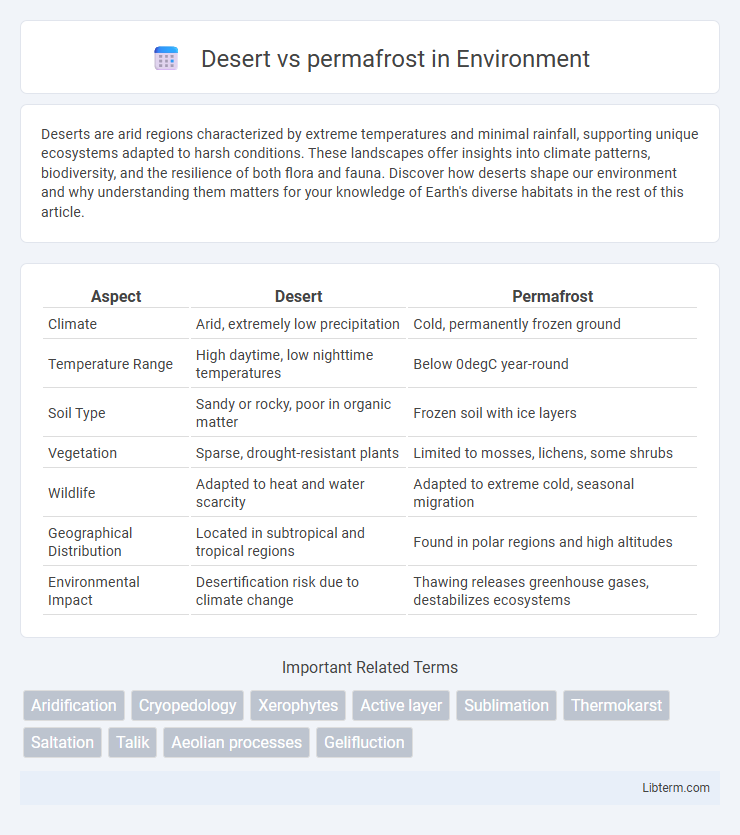Deserts are arid regions characterized by extreme temperatures and minimal rainfall, supporting unique ecosystems adapted to harsh conditions. These landscapes offer insights into climate patterns, biodiversity, and the resilience of both flora and fauna. Discover how deserts shape our environment and why understanding them matters for your knowledge of Earth's diverse habitats in the rest of this article.
Table of Comparison
| Aspect | Desert | Permafrost |
|---|---|---|
| Climate | Arid, extremely low precipitation | Cold, permanently frozen ground |
| Temperature Range | High daytime, low nighttime temperatures | Below 0degC year-round |
| Soil Type | Sandy or rocky, poor in organic matter | Frozen soil with ice layers |
| Vegetation | Sparse, drought-resistant plants | Limited to mosses, lichens, some shrubs |
| Wildlife | Adapted to heat and water scarcity | Adapted to extreme cold, seasonal migration |
| Geographical Distribution | Located in subtropical and tropical regions | Found in polar regions and high altitudes |
| Environmental Impact | Desertification risk due to climate change | Thawing releases greenhouse gases, destabilizes ecosystems |
Introduction to Desert and Permafrost Environments
Desert environments are characterized by extremely low precipitation, sparse vegetation, and high temperature fluctuations, supporting specialized ecosystems adapted to arid conditions. Permafrost environments consist of permanently frozen soil or rock layers, primarily found in polar and subpolar regions, where low temperatures limit microbial activity and plant growth. Both environments represent extreme habitats that pose unique challenges for flora, fauna, and human activity due to moisture availability and temperature extremes.
Geographic Distribution and Locations
Deserts primarily span the subtropical regions between 15deg and 35deg latitudes, with prominent examples including the Sahara in Africa, the Arabian Desert in the Middle East, and the Mojave in North America. Permafrost is predominantly found in high-latitude polar and subpolar regions such as Siberia, Alaska, northern Canada, and Greenland, where ground temperatures remain below freezing for at least two consecutive years. The geographic distribution of deserts and permafrost reflects contrasting climatic zones: deserts thrive in dry, often warm environments, while permafrost zones occur in cold, often moist arctic and subarctic climates.
Climate Characteristics: Heat vs. Cold
Deserts experience extreme heat with daytime temperatures often exceeding 40degC (104degF) and minimal precipitation, leading to arid conditions and sparse vegetation. Permafrost regions maintain temperatures consistently below 0degC (32degF) for at least two consecutive years, resulting in permanently frozen ground and limited biological activity. The stark contrast in thermal profiles drives unique environmental and ecological processes in each landscape.
Soil Composition and Structure
Desert soils are typically sandy or rocky, characterized by low organic matter, poor water retention, and high mineral content, leading to loose, well-drained structures prone to erosion. Permafrost soils contain frozen organic material and mineral layers beneath a seasonally thawed active layer, resulting in dense, compacted structures with limited drainage and slow decomposition rates. These contrasting soil compositions significantly influence vegetation types and ecosystem dynamics in desert and permafrost regions.
Water Availability and Sources
Deserts experience extremely limited water availability due to minimal precipitation, relying primarily on sporadic rainfall and occasional underground aquifers for moisture. Permafrost regions contain abundant water trapped as ice within the permanently frozen soil, which becomes accessible during seasonal thawing periods. The contrast in water sources highlights deserts' dependence on scarce liquid water versus permafrost's reliance on frozen water reserves.
Biodiversity and Adapted Lifeforms
Deserts host biodiversity with species adapted to extreme heat and scarce water, including cacti, reptiles, and nocturnal mammals specialized in water conservation and temperature regulation. Permafrost regions support cold-tolerant organisms such as mosses, lichens, arctic foxes, and caribou, with microbial life uniquely capable of surviving frozen soils and seasonal thaw cycles. Both ecosystems showcase evolutionary adaptations for survival under extreme environmental pressures, but desert fauna and flora prioritize drought resistance while permafrost species emphasize cold endurance and seasonal metabolic flexibility.
Challenges for Human Habitation
Deserts present extreme heat, scarce water resources, and limited vegetation, making access to potable water and agriculture critical challenges for human habitation. Permafrost regions face unstable ground due to seasonal thawing, releasing greenhouse gases and complicating infrastructure development with freezing and thawing cycles. Both environments require advanced adaptation strategies for sustainable living, including water management in deserts and construction techniques resilient to permafrost dynamics.
Ecosystem Services and Functions
Desert ecosystems provide crucial services such as carbon sequestration through sparse vegetation, habitat for specialized flora and fauna, and regulation of local climate via heat absorption and dust generation. Permafrost regions store vast amounts of organic carbon, acting as a significant carbon sink and influencing global climate regulation through soil moisture retention and nutrient cycling. Both ecosystems support unique biodiversity and contribute to water filtration, though permafrost areas play a more prominent role in maintaining long-term climate stability due to frozen ground and slow decomposition rates.
Environmental Threats and Climate Change Impact
Deserts face environmental threats such as desertification, loss of biodiversity, and increased water scarcity due to rising temperatures and prolonged droughts linked to climate change. Permafrost regions are highly vulnerable to thawing caused by global warming, releasing significant amounts of methane and carbon dioxide, which further accelerate climate change and destabilize ecosystems. Both biomes illustrate critical feedback loops where climate change exacerbates environmental degradation, threatening global ecological balance.
Comparative Summary: Desert vs. Permafrost
Deserts exhibit extremely low precipitation and high temperature variability, resulting in sparse vegetation and arid landscapes, whereas permafrost regions maintain permanently frozen soil with limited thaw depth, primarily influencing cold-climate ecosystems. Soil composition in deserts is typically sandy or rocky with poor moisture retention, contrasting with the ice-rich soil and organic matter commonly found in permafrost areas. Both environments affect biodiversity and human activity differently, with deserts challenging water availability and permafrost regions posing infrastructure risks due to ground instability from thawing.
Desert Infographic

 libterm.com
libterm.com